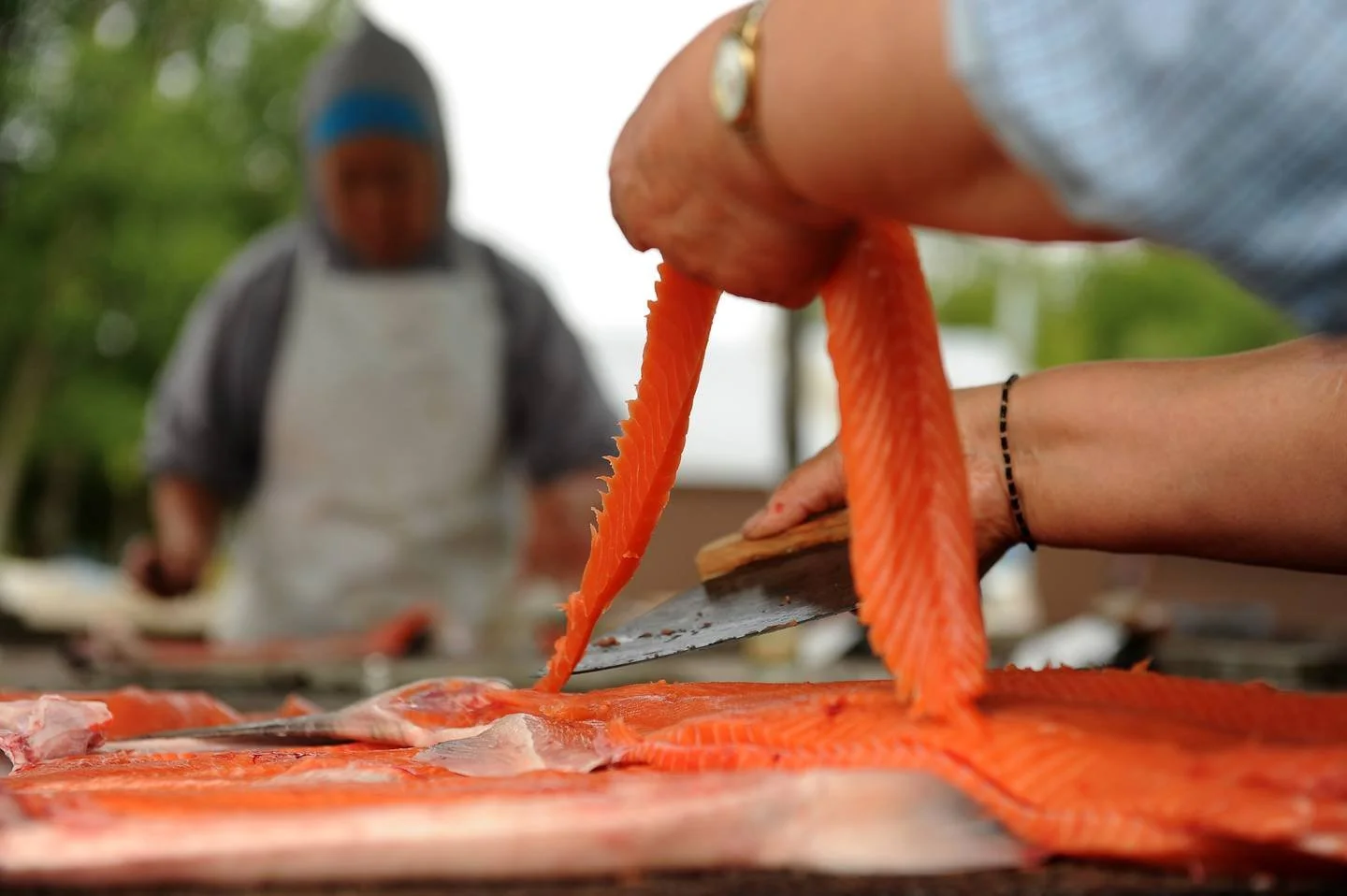OPINION: Western Alaska salmon numbers continue to fall — and that’s a serious threat to food security and indigenous cultures
This opinion piece was co-authored by Melanie Bahnke of Kawerak Inc., Vivian Korthuis of AVCP, Brian Ridley of TCC, Fred Phillip of BSEG, Kevin Whitworth of KRITFC, and Brooke Woods of YRITFC. These organizations represent over 100 Tribes in Western and Interior Alaska. It was originally published in the Anchorage Daily News on May 31, 2022.
Photo: Salmon being prepared at a fish camp on the Kuskokwim River near Bethel in 2014. (Bob Hallinen/ADN archive).
Across Western and Interior Alaska, early summer is normally a joyful time of year, full of preparations for fishing and the anticipation of fresh salmon. This is a time when we look forward to fish camp, where our families gather around the cutting table with multiple generations and our children learn how to check the net and process the fish at the smokehouse. They learn to give their first catch to elders, sharing with those who taught them the traditional Indigenous knowledge that has guided and informed salmon harvesting practices for generations.
This year, however, we face the grim prospects of yet another season without the salmon which are the lifeblood of our Yup’ik, Cup’ik, Athabascan and Inupiaq people in rural Western and Interior Alaska. Without these fish, our meals are incomplete, our physical and mental health suffers and our families and communities are negatively impacted. Without salmon, our tribes lack wellness, kinship, generational learning, cultural enrichment and nutritional intake.
Chinook and chum salmon populations continue to rapidly decline, posing a threat to food and cultural security for over 100 tribes in the region with the state’s highest subsistence dependence.
In 2021, subsistence salmon fishing was severely or completely restricted on the Yukon and Kuskokwim Rivers, and in the Norton Sound area. No typical in-river commercial openers took place on any of our rivers. Without fishing, our smokehouses were empty and fish camps were silent. We fear the same will happen this year, as chinook and chum salmon returns are again predicted to be poor throughout Western and Interior Alaska.
While subsistence fishermen keep their boats tied to the shore, factory trawlers in the Bering Sea and Aleutian Islands are allowed to catch the same chinook and chum salmon bound for our rivers as bycatch, or unintended prohibited species catch, as they trawl for pollock. Already in 2022, the pollock fleet has killed more than 5,184 chinook salmon as bycatch; in 2021, they caught more than 15,000 chinook salmon as bycatch. While chum salmon struggle in-river, in 2021, the pollock fleet caught more than 550,000 chum salmon as bycatch. While not all these fish are bound for our rivers, many are, and instead of returning home to their natal rivers and nourishing our tribes, cultures and families, these fish are killed and discarded at great cost to our people and the ecosystem.
Tribes have been calling for reductions in salmon bycatch for years. Yet under the current rules set by the North Pacific Fishery Management Council and National Marine Fisheries Service, the pollock fleet is legally allowed to catch up to 45,000 chinook salmon and — even more troubling — an unlimited amount of chum salmon in 2022.
Why are we — the local people who depend on these fish for our physical, spiritual and cultural survival — restricted from taking a single salmon, while factory trawlers are allowed to kill tens of thousands? Federal management bodies are obligated to manage fisheries and the continued existence of our salmon -- when will they act? How much longer will they wait?
Tribes and rural communities have made tremendous sacrifices to protect and restore our once abundant salmon runs by forgoing our subsistence and commercial harvests, engaging in research, and monitoring and pushing for management changes amid this salmon collapse. We can all agree that the only truly acceptable amount of bycatch is zero, and we must be continually striving toward this goal. We call on the North Pacific Fishery Management Council, Gov. Dunleavy, and ADF&G Commissioner Doug Vincent-Lang to take every possible action to reduce bycatch significantly when they meet in Sitka in June by lowering the chinook salmon caps and establishing a hard cap for chum salmon.
Restricting the way of life for subsistence users is not working; runs will not improve, and escapement goals will not be met, until we all share the burden of conservation.
We also encourage the council and its staff to collaborate with tribes on identifying research priorities and management actions. We want to be included in researching, managing and monitoring the fish and ecosystems we depend on. Our communities are at the forefront of the many changes occurring across the Arctic, including species declines and climate change. Through a co-productive approach, our traditional Indigenous knowledge — a science in and of itself ― can enhance our collective efforts and equitably bring together Indigenous peoples’ knowledge and Western science.
Our people are ready for action. We are ready for the waste and injustice of salmon bycatch to end. We are ready to return to our fish camps, nets and uluaqs in hand, our children by our sides, learning and practicing our traditional ways of life.
Melanie Bahnke is president of Kawerak, Inc. Vivian Korthuis is CEO of the Association of Village Council Presidents. Brian Ridley is chief and chairman of the Tanana Chiefs Conference. Fred Phillip is chair of the Bering Sea Elders Group. Kevin Whitworth is interim executive director of the Kuskokwim River Inter-Tribal Fish Commission. Brooke Woods is chairwoman of the Yukon River Inter-Tribal Fish Commission.

